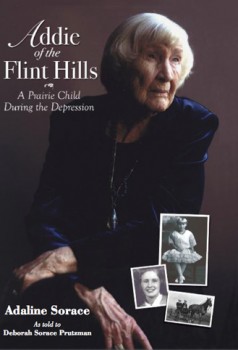Today’s guest post, “How to Write a Memoir with a Partner” is by Deborah Prutzman, co-author of Addie of the Flint Hills: A Prairie Child During the Depression (1915-1935) (aff link).
Few writers would argue that writing is a solitary pursuit. That said, collaborations between two or more writers do occur, and some have been highly successful. This is especially true when it comes to memoirs. Why? Because often one person has a remarkable story to tell but is not a professional writer, and the other person is needed to help write the personal story (and tell it in a most compelling way).
Sometimes that person is a relative or friend. Sometimes that person is a professional, paid ghostwriter or editor. In my case, I helped my mom write her memoir. At age 94 she had an interesting story to tell but needed my help to access her memories and then organize and write them in the form of a book. This was our first collaboration but hopefully not our last, because Mom wants to do a whole series of books!
In writing this memoir with my mother, I learned a lot and am delighted to be able to share my lessons learned, some of which will hopefully be helpful to you.
How to Write a Memoir
- Start with whatever your partner can do. It can be a recorded or written list or a spoken dialogue about his or her life. If your partner cannot start, you might offer a list of key events and ask for feedback, thoughts, and reactions about these or inquire about how friends and family were affected by these events.
- Develop a list of questions on a specific topic coming from multiple angles and ask about one or two each time you meet.
- Listen and write everything down. You may not think something your partner says is significant, but months later you will see why it matters.
- Let your partner repeat stories, and view this as a chance to get new details and better words.
- Tell others about the effort. Many of our friends and relatives sent photos or came to visit and told Mom stories. Some of this material made its way into the book. Some triggered memories, which was also wonderful for all of us.
- Have your partner answer three overarching questions, appropriate to the time, and weave these into the book. These can differ based on your interests and the interests of your partner and family, friends, or business associates. I asked my mother what was her experience of the moment, what was the family dynamic in her judgment now, looking back, and how did the economy back then impact her.
- Buy books, music, and videos of the places and times to trigger memories. Mom would look at these on her own and write down a memory or thought that these brought to mind. Many of these comments were incorporated into the text. As part of the research I also reached out to local historical societies, and went on eBay looking for relevant items, old postcards, programs, etc. Also, reviewing the materials provided hours of fun for her while I was not there.
- Read, reread, and discuss the draft text. Again, this provided many enjoyable hours for Mom when she was otherwise alone. Often I asked her to focus on a theme or a person and spend the next few days writing down whatever came to mind.
- Always work with whatever your partner’s natural tendency is. Nail it down and then push for the opposite. My mother was very factual; almost matter of fact and devoid of emotion. I captured that, and then pushed to find the little details that hinted at the emotions, which began slowly but surely to release the flood of feelings!
- Have a professional editor go over the manuscript for typos, grammar, and punctuation and also to edit out any redundancies.
More Thoughts on How to Write a Memoir
It was a simple production. We gathered all the family photos we could find and put them in a more or less chronological order. Mom thought about her life and we agreed on a loose script. Then I asked questions and she responded. We edited it down to an hour or two and were very satisfied with our results. When I finally suggested that Mom write down her memories, she had a framework.
The bones of the story are the partner’s life, the person who lived the events (unless you both did). What really matters is capturing that person’s thoughts and experiences, so be nonjudgmental in order to freely allow your partner to lead you down the path of his or her past. With my mother, I tried to be curious about why she thought and felt certain things. I am a lawyer and a pretty strong woman, so the role of a more passive partner is not one that I am all that comfortable with. It took effort, but I was able to channel her thoughts and experiences. Working on the book brought all sorts of good things to my family and most of all, brought Mom and me closer together.
When the memoir I wrote with my mother was finished, we found a publisher, hired a publicist, and then went back to Mom’s local roots for a mini book tour, which was highly successful. Mom loves to read and re-read her book. Now we are going on to the next 20 years. I hope you and your writing partner are equally delighted with the end result of your venture.
To learn more about the memoir that Deborah wrote with her mother (aff link), and to get more tips on how to write a memoir, please visit www.adalinesorace.com.





